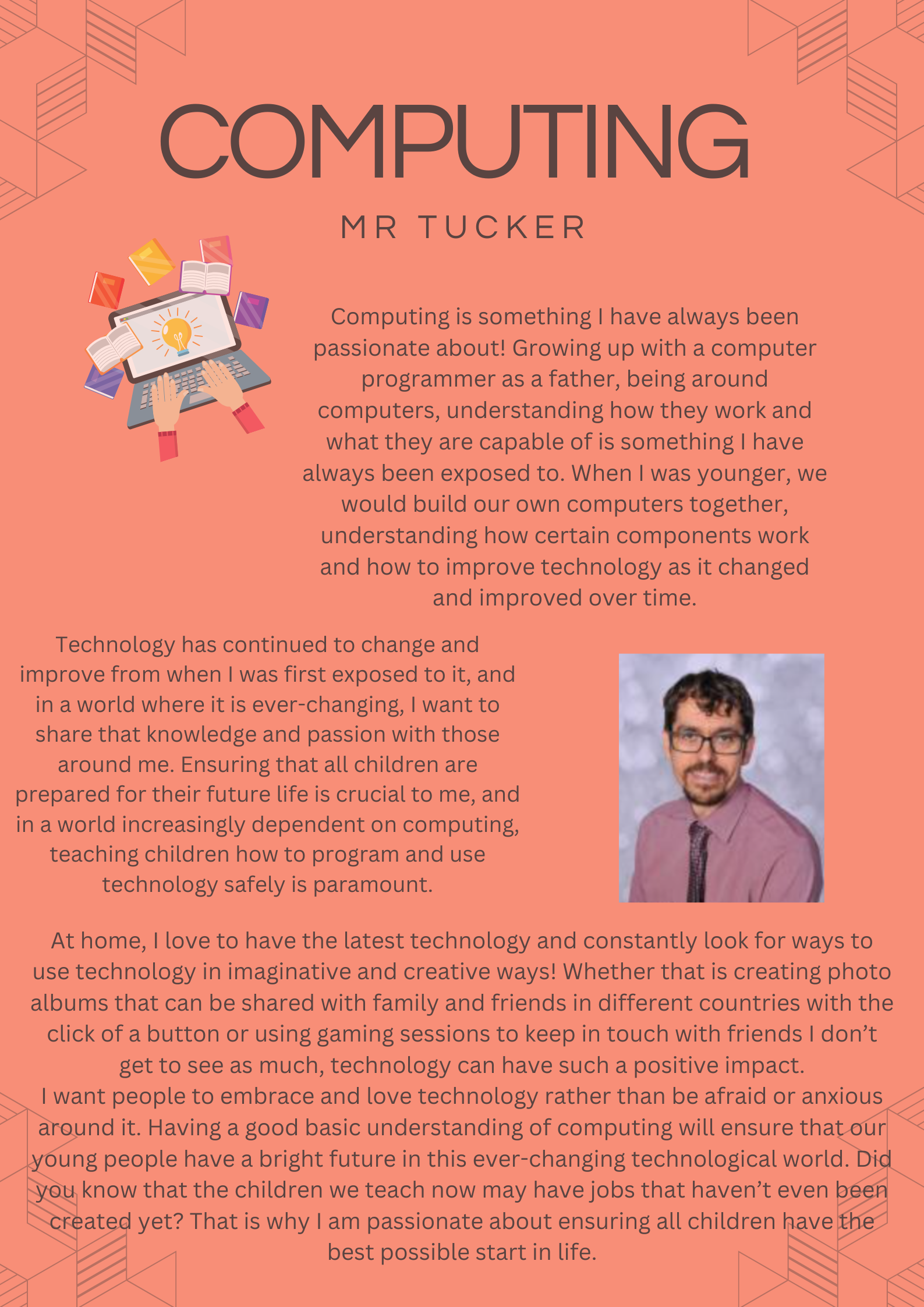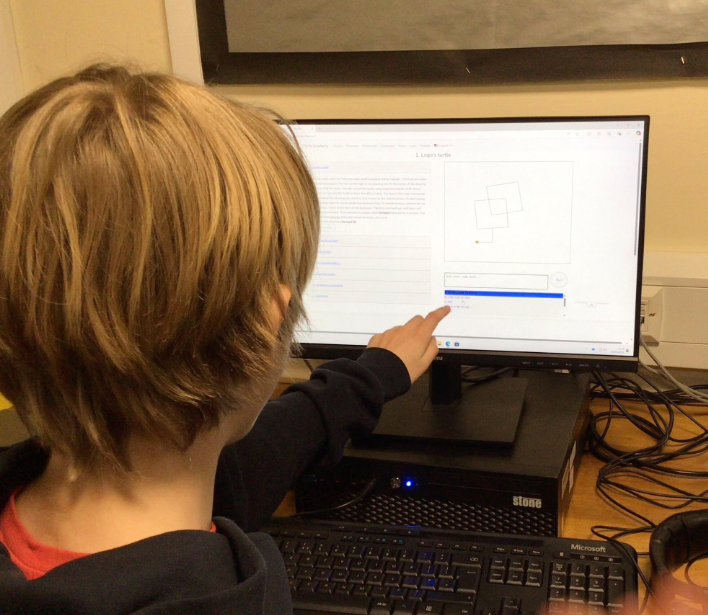COMPUTING
Computing at Tillington Manor Primary School
Pupils are introduced to a wide range of technology including Beebots, iPads, Chromebooks and interactive whiteboards which allow them to continually improve and develop their ideas and skills. The sequence of learning develops pupils’ understanding of how digital technology and other computational systems are designed, programmed and operated. As pupils progress through the school and build upon their computational thinking skills they then feel confident in drawing upon familiar and unfamiliar technology and software. Our Computing Lead is Mr Tucker


At Tillington Manor, we also believe that Computing enhances our teaching and learning in invaluable ways and so we aim to use our computing skills in as many subjects as possible. Through allowing computing to be used in creative ways across the curriculum, pupils recognise the benefits of becoming digitally literate for both their present and future selves. Not only are the ideas of Computing applied to the wider curriculum, they are also applied to the understanding of real-world systems and products. We encourage pupils to be creative, innovative, purposeful and resourceful in all of their endeavours – we believe that being critical thinkers who are digitally literate will empower our pupils to strive for all of these traits.
From EYFS through to KS2 the pupils of Tillington Manor are taught how to use digital technology safely, respectfully and responsibly. Younger pupils are regularly taught what to do if something makes them feel uncomfortable whilst using technology. As our pupils progress through the school they learn the importance of keeping personal information private. We pride ourselves in our pupils’ ability to recognise differences between acceptable and unacceptable behaviour online and how to approach this. Pupils learn from EYFS where they can go for help and support when they have concerns about content. KS2 pupils are able to recognise a range of ways to disclose concerns about content and uncomfortable experiences when using technological devices.
INTENT
Through our computing curriculum at Tillington Manor we aim to give our pupils the life-skills that will enable them to embrace and utilise new technology in a creative, as well as responsible and safe way in order to flourish. Our curriculum recognises that all children have the right to learning experiences that balance all aspects of Computing. We acknowledge that technological devices and software are an integral part of everyday life and that society is becoming more and more reliant on technology to guide, innovate and develop practice in many sectors of work, education, and daily life.
We want our pupils to be able to operate in the 21st century workplace and we want them to know the career opportunities with Digital organisations around Stafford/Staffordshire including GE, Connexia and Langley Foxall. We want children to become autonomous, independent users of computing technologies, gaining confidence and enjoyment from their activities. We want the use of technology to support learning across the entire curriculum and to ensure that our curriculum is accessible to every child. Not only do we want them to be digitally literate and competent end-users of technology but through our computing lessons we want them to develop creativity, resilience and problem-solving, and critical thinking skills. We want our pupils to have a breadth of experience to develop their understanding of themselves as individuals within their community but also as members of a wider global community and as responsible digital citizens.
IMPLEMENTATION
The computing curriculum at Tillington Manor has been tailored to focus and build upon the three core aspects of Computing; Digital Literacy, Computer Science, and Information Technology. We do so with a progression framework of skills and knowledge that allows the pupil to make the necessary connections within their learning as they progress through the Computing Curriculum. We use this framework to create a scheme of work for each year group building upon the skills learned in previous years.
Our scheme of work for 2024-2025 uses DFE funded Teach Computing (https://teachcomputing.org) which has been customised for schools to include relevant digital and learning resources. We also use a range of localised Online Resources from BGFL (Inc. Busythings & J2E), and Discovery Education, while maximising the best national and global open resources for teaching Computing including Scratch, Barefoot Computing and Common-Sense Media. Through doing so we embed the effective legacy of Remote Learning, enable improved Progress and Portfolio Development, and provide more structured weekly Computing lessons and half termly units of work for all three strands of the curriculum.
You can find our 2025-2026 Computing Curriculum here – Computing Curriculum Overview
You can find our Computing Journey here – Tillington’s Computing Journey
Please see our EYFS page for our Nursery and Reception curriculum information but please also click here to see how we provide a foundation of computing skills and knowledge in our Early Years
IMPACT
Our approach to the curriculum results in a relevant, engaging, and high-quality computing education. The quality of children’s learning is evidenced in online folders and portfolios including OneDrive, Scratch, and Seesaw (archives).
Evidence such as this is used to feed into teachers’ future planning, and as a topic-based approach continues to be developed, teachers are able to revisit misconceptions and knowledge gaps in computing when teaching other curriculum areas. This supports varied paces of learning and ensures all pupils make good progress.
By the end of Year 6 at Tillington Manor, pupils should feel confident in using a range of technology. They should be able to recognise how to keep themselves safe online, and they should understand the importance of being an exceptionally good digital citizen. Pupils should have a sound knowledge of up to date technologies and how they can be used to enhance their learning and the curriculum.
EYFS
From the moment the children enter the EYFS setting they have the opportunity to use a range of technology, from using iPads to record their work, to scanning QR codes to see work they have done in other lessons. The pupils in EYFS also have access to talking clipboards, and talking story books which enable them to listen to instructions from the teacher, as well as recording their own ideas/ stories to aid with sentence writing. We also provide pupils with defunct IT equipment to encourage them to construct their own imaginative role-play scenarios. Pupils in EYFS are also given the opportunity to use remote control toys, and programmable toys to enhance multiple areas of the curriculum. Through exposing pupils in EYFS to a range of digital technology, we are ensuring they understand the world around them whilst ensuring that they are building skills to aid them in key stage learning.
You can find how we encourage computing in EYFS here – How Computing is used in EYFS

KS1
Pupils continue to recognise digital technology in the wider society and they begin to explore the use and impact of technology in the world around them. They gain an understanding of what algorithms are, how they are used as programmes on digital devices and the importance of precise instructions. With this knowledge our KS1 pupils create and debug simple programs, they also programme robotic toys while predicting the outcome of simple algorithms. Our pupils also begin to learn how to create, edit, store, and retrieve digital content using apps and online software.
You can find our KS1 curriculum journey here – Curriculum Overview
KS2
In KS2 pupils are confident in their safe use of the internet, and they understand the opportunities the World Wide Web offers for collaboration and communication. They learn about the various search engines available to them and how these computing networks communicate with each other and the user. Pupils acquire a secure understanding and ability to engage with a range of programs, software, devices, and websites through lessons that are underpinned with the principles of Digital Literacy and Online Safety with safe and best practices referenced whenever appropriate.
Pupils also continue to develop and expand their knowledge of computational systems and digital technology. Pupils in KS2 design, write and debug programmes that have specific goals and target audiences. They use sequence, selection, and repetition in programmes and understand how variables, inputs, and outputs can affect the programmed algorithm. Pupils further build on their logical reasoning skills to decompose problems into smaller, more manageable parts in order to both build their program, recognise problems, debug, and correct errors in code written by both themselves and their peers. KS2 pupils are able to evaluate their work, and recognise ways to improve.
You can find our KS2 curriculum journey here – KS2 Teaching Overview
Useful Documents & Links
Computing Curriculum Overview 2024-2025
Primary National Curriculum for Computing
Helpful Educational websites and apps
The Children’s Commissioner’s Digital 5-A-Day
https://www.barefootcomputing.org/homelearning
We follow the Teach Computing Scheme of Work from Year 1 to Year 6. Click on the link below to find more information about Teach Computing and the work they do to help schools: Teach Computing
Click on this link to find the subject practice statement.
Click on this link to see the progression of skills